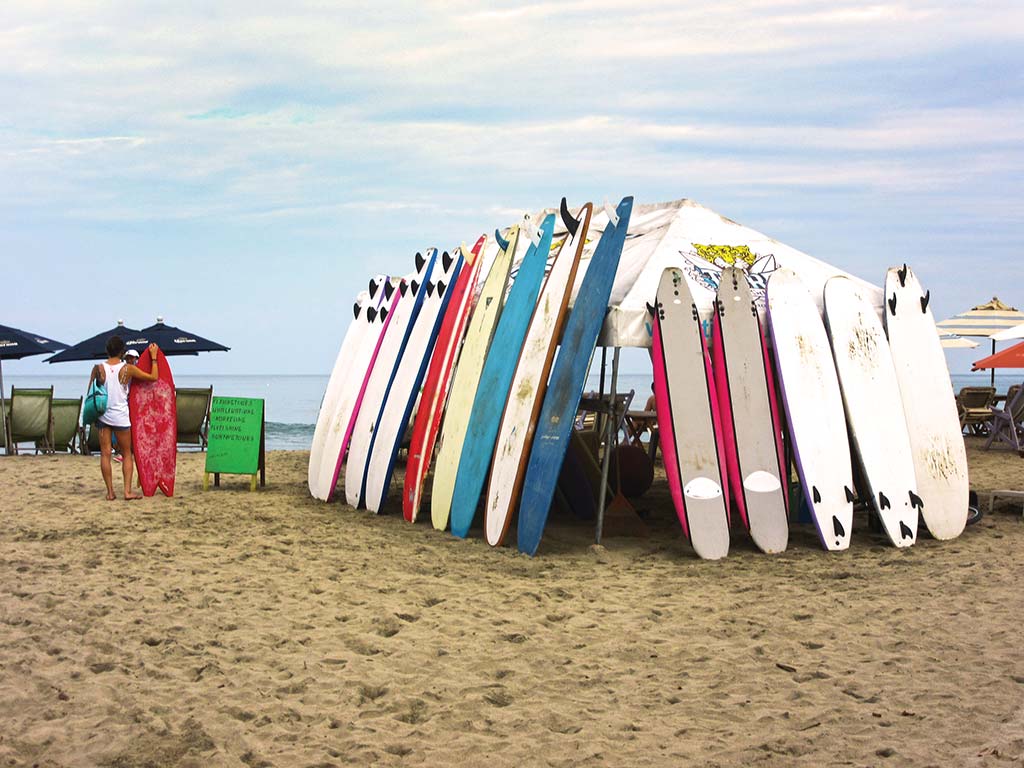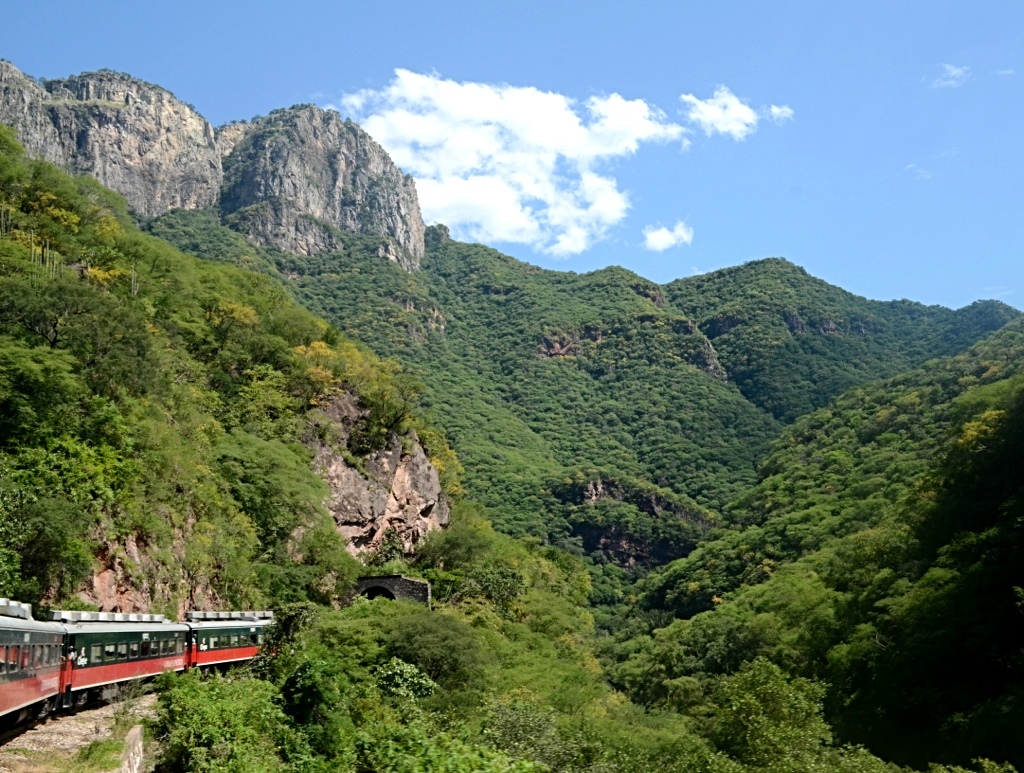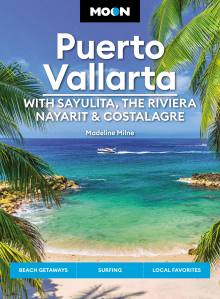Getting to Puerto Vallarta by Air, Bus, Train, or Ferry
The vast majority of travelers reach Puerto Vallarta by air. Flights are frequent and reasonably priced, although the airlines have cut back on the number of flights in recent years, and in some cases raised prices. Competition sometimes shaves tariffs to as low as $275 for a Puerto Vallarta low-season round-trip from the departure gateways of San Francisco, Los Angeles, Denver, Dallas, Phoenix, or Houston. Air travelers can save lots of money by shopping around. Don’t be bashful about asking for the cheapest price. Make it clear to the airline or travel agent that you’re interested in a bargain. Ask the right questions: Are there special-incentive, advance-payment, night, midweek, tour-package, or charter fares? Peruse the ads in the Sunday newspaper travel section for bargain-oriented travel agencies. Check airline and bargain-oriented travel websites.

Although some agents charge booking fees and don’t like discounted tickets because their fee depends on a percentage of ticket price, many will nevertheless work hard to get you a bargain, especially if you book an entire air-hotel package with them.
Although only a sprinkling of airlines fly directly to Puerto Vallarta from the northern United States and Canada, many charters do. In locales near Vancouver, Calgary, Ottawa, Toronto, Montréal, Minneapolis, Chicago, Detroit, Cleveland, and New York, consult a travel agent for charter flight options. Be aware that charter reservations, which often require fixed departure and return dates and provide minimal cancellation refunds, decrease your flexibility. If available charter choices are unsatisfactory, then you might choose to begin your vacation with a connecting flight to one of the Puerto Vallarta gateways of San Francisco, Los Angeles, San Diego, Denver, Phoenix, Dallas, Houston, Atlanta, Chicago, San Jose, or Oakland.
By Air From Europe, Latin America, and Australia
A few airlines fly across the Atlantic directly to Mexico City, where easy Puerto Vallarta connections are available via VivaAerobus, Copa, and Aeroméxico. These include Lufthansa, which connects directly from Frankfurt, and Aeroméxico, which connects directly from Paris and Madrid.

From Latin America, Aeroméxico connects directly with Mexico City, customarily with São Paulo, Brazil; Santiago, Chile; Lima, Peru; Buenos Aires, Argentina; and Bogota, Colombia. They also connect directly with Guatemala City, San Jose in Costa Rica, San Pedro Sula in Honduras, and San Salvador in El Salvador. A number of other Latin American carriers also fly directly to Mexico City.
Very few flights cross the Pacific directly to Mexico, but Japan Airlines connects Tokyo to Mexico City via Los Angeles or Dallas. More commonly, travelers from Australasia transfer at New York, Chicago, Dallas, San Francisco, or Los Angeles for Puerto Vallarta.
Getting to Puerto Vallarta by Bus
As air travel rules in the United States, bus travel rules in Mexico. Hundreds of sleek, first-class bus lines such as Elite, Turistar, Futura, Transportes Pacífico, and White Star (Estrella Blanca) depart the border daily, headed for the Puerto Vallarta region.
Since North American bus lines ordinarily terminate just north of the Mexican border, you must usually disembark and continue on foot across the border to the Mexican immigration office (migración). There, after having filled out the necessary but very simple paperwork, you can walk outside and bargain with one of the local taxis to drive you the few miles to the camionera central (central bus station).
First-class bus service in Mexico is much cheaper and more frequent than in the United States. Tickets for comparable trips in Mexico cost a fraction (around $80 for a 1,000-mile trip, compared with about $120 in the United States).
In Mexico, as on U.S. buses, you often have to take it as you find it. Asientos reservados (seat reservations), boletos (tickets), and information must generally be obtained in person at the bus station, and credit cards and travelers checks are not often accepted. Nor are reserved bus tickets typically refundable, so don’t miss the bus. On the other hand, plenty of buses roll south almost continually.
Newsletter Signup
By clicking ‘Sign Up,’ I acknowledge that I have read and agree to Hachette Book Group’s Privacy Policy and Terms of Use
Bus Routes to Puerto Vallarta
From California and the western United States, cross the border to Tijuana, Mexicali, or Nogales, where you can ride one of at least three bus lines along the Pacific coast route (National Highway 15) south to Puerto Vallarta by Estrella Blanca (via its subsidiaries, Elite, Transportes Norte de Sonora, or Turistar) or independents Transportes Pacífico or Transportes y Autobuses del Pacífico (TAP).
A few Estrella Blanca and Transportes Pacífico departures may go all the way from the border to Puerto Vallarta. Otherwise, you will have to change buses at Mazatlán or Tepic, depending on your connection. Allow a full day and a bit more (about 30 hours), depending upon connections, for the trip. Carry liquids and food (which might be only minimally available en route) with you.
From the midwestern United States, cross the border from El Paso to Juárez and head for Mazatlán by way of Chihuahua and Durango by either Estrella Blanca (via subsidiaries Transportes Chihuahuenses or super-first-class Turistar) or independent Ómnibus de Mexico. Both Transportes Chihuahuenses and Turistar usually offer a few daily departures direct to Mazatlán. Otherwise, transfer at Durango to a Mazatlán-bound bus and continue south to Puerto Vallarta as described earlier.
From the southeastern and eastern United States, cross the border at Laredo to Nuevo Laredo and ride Transportes Norte de Sonora or Turistar direct to Mazatlán, or to Durango. At Durango, transfer to a Mazatlán bus, where you can continue south to Puerto Vallarta, as described previously.
From the central or eastern United States, it may be more convenient to ride a bus from the border direct to Guadalajara, where you can easily transfer to one of many buses bound for Puerto Vallarta.
Getting to Puerto Vallarta by Train
Privatization has put an end to most passenger train service in Mexico, with the exception of the Copper Canyon scenic route. One of the few remaining passenger train rides in Mexico typically begins with a bus trip or flight south to Chihuahua, where you board the Chihuahua-Pacific Railway train and ride west along the renowned Copper Canyon (Barranca del Cobre) route to the Pacific. Only finished during the early 1960s, this route traverses the spectacular canyon-land home of the Tarahumara people. At times along the winding 406-mile (654-km) route, your rail car seems to teeter at the very edge of the labyrinthine Barranca del Cobre, a canyon so deep that its climate varies from Canadian at the top to tropical jungle at the bottom.
The railway-stop village of Creel, with a few stores and hotels and a Tarahumara mission, is the major jumping-off point for trips into the canyon. For a treat, reserve a stay en route to Puerto Vallarta at the Sierra Lodge (call Yolanda in the United States at 360/588-1290 or Martha Elena Carbajal in Chihuahua at 01-800/830-8325, ) in Creel. From there, the canyon beckons: Explore the village, enjoy panoramic views, observe mountain wildlife, and breathe pine-scented mountain air. Farther afield, you can hike to a hot spring or spend a few days exploring the canyon bottom itself, with overnights at the Riverside Lodge in the rustic village of Batopilas.

Copper Canyon Tours
Some agencies arrange unusually good Copper Canyon rail tours. Among the best is Baja-based Copper Canyon Travel (154 Terrasol, Av. Solmar, Cabo San Lucas, Baja California Sur, C.P. 23450, tel. 624/143-4400 or 624/178-0413), which employs its own resident guides. Trips range from small-group, rail-based sightseeing and birding/natural history tours to customized wilderness rail-Jeep-backpacking adventures.
Nature Treks (P.O. Box 542, Bryantville, MA 02327, tel. 781/789-8127, ) offers a birding tour of the canyon as well as a six-day hike with pack burros and experienced Mexican and Tarahumara guides into some of the more remote areas of the canyon. All trips begin with the spectacular Copper Canyon train trip from Los Mochis on the coast.
Getting to Puerto Vallarta by Ferry
An alternative route to Puerto Vallarta is by ferry from the southern tip of Baja California. Bus travelers should cross the border at Tijuana or Mexicali and ride Autobuses Blanca Coordinados (ABC, Tijuana local tel. 664/621-2424, toll-free Mex. tel. 01-800/025-0222) through the long desert to La Paz (about 20 hours). Car travelers also cross at Tijuana or Mexicali and follow good two-lane Mexico National Highway 1, a long 900 miles (1,500 km) south to La Paz.
At La Paz (a pleasant, midsize Mexican fishing port and busy resort destination, although it’s usually very hot in the late spring and summer), you have your choice of two ferry crossings. Baja Ferries (at the La Paz ferry dock, toll-free Mex. tel. 01-800/337-7437, from U.S. dial direct 01152-612/125-6324, fax 01152-612/123-0504) ferries passengers and vehicles between La Paz and Topolobampo, near Los Mochis in northern Sinaloa (rates are one-way: about $60 per adult, kids $30, cars about $85, motor homes about double), and between La Paz and Mazatlán ($68, $34, and $170 respectively) in southern Sinaloa. Note: If you’re planning on continuing south to Puerto Vallarta, you should probably opt for the Mazatlán crossing. Although it won’t save you much time (since the bus or your vehicle travels much faster than the ferry), you might save the price of a hotel room and highway tolls (or bus fare).
The La Paz-Topolobampo run goes via the excellent Italian-built 1,000-passenger California Star. As of this writing, it leaves La Paz Monday-Friday at 2:30pm, Saturday at 11pm, and takes 6.5 hours. The La Paz-Mazatlán run, on the older Mazatlan Star, leaves La Paz Tuesday and Thursday at 6pm and Sunday at 5pm, and takes 18 hours. Although seats are provided, you may want to reserve one of their clean cabins with beds and private toilet (about $60 for a cabin). Ferry facilities on both runs include bar, lounge, and restaurant, but pets are not allowed, and passengers are not allowed to stay in their vehicles during the crossing. MasterCard and Visa are accepted for payment.
Reservations are recommended at all times and are a must during the supercrowded Christmas and Easter holidays. You can make reservations either through the website www.bajaferries.com or directly at any of the many reservations/ticket-sales offices that the website lists. Of all of these, the most useful would probably be their U.S. agent, Native Trails (613 Queretaro, El Paso, TX 79912-2210, tel. 915/833-3107, fax 915/585-7027), or the La Paz sales office, which has English-speaking agents (corner of Isabel la Catolica and Navarro, tel. 612/125-7443, toll-free Mex. tel. 01-800/122-1414, fax 612/125-7444).
Although greatly improved in recent years, Baja ferry service is subject to change. Be sure to check by phone or Internet for the newest ferry information before making the long desert trip south to La Paz.
Newsletter Signup
By clicking ‘Sign Up,’ I acknowledge that I have read and agree to Hachette Book Group’s Privacy Policy and Terms of Use
Pin it for Later


